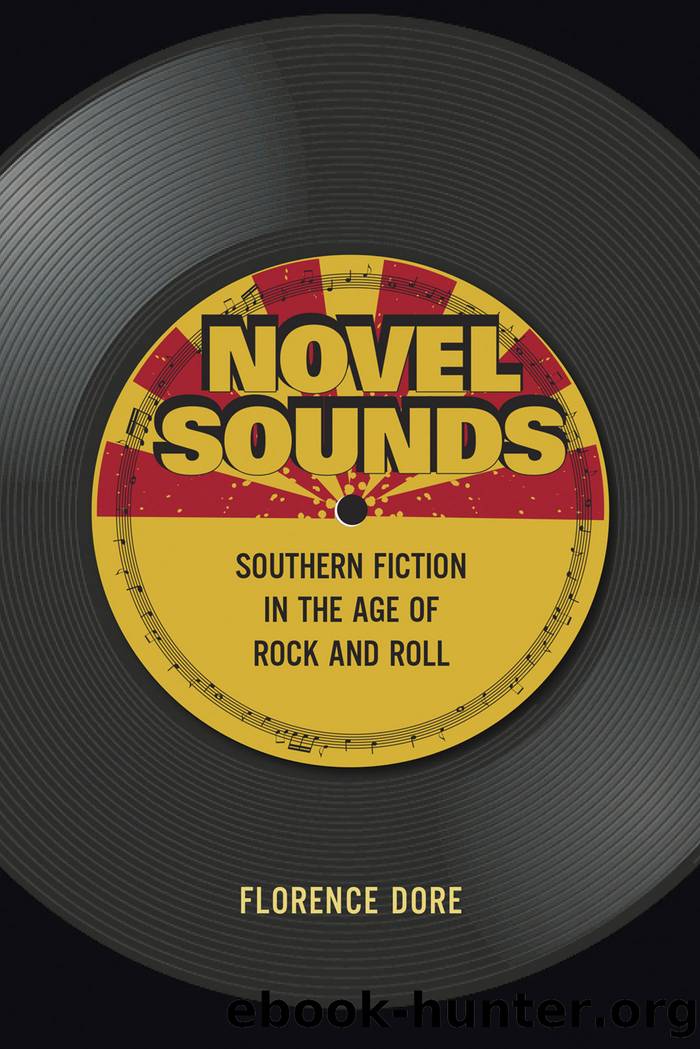Novel Sounds by Florence Dore

Author:Florence Dore [Dore, Florence]
Language: eng
Format: epub
Publisher: Columbia University Press
Published: 2018-05-15T00:00:00+00:00
It was a scratchy hoarse monster but I had a few records: The Magic Flute and Don Giovanni and some early Haydn and Christian Bach and the St. Matthew Passion and a Palestrina mass and—oh yes, I had an ancient Leadbelly [sic] album with about every record held together by Scotch tape. Old Leadbelly. Every time I heard “The Midnight Special” I got right back to Carolina.
(255)
Here, in the narrative present, Styron portrays Cass recounting for Peter a past event in Italy in which an “ancient” Lead Belly record “got” him “right back to Carolina.”15 In the memory he relays in the present, the loud-as-hell voice coming from the “scratchy hoarse monster” transports Cass to his origin in North Carolina. And Cass’s present speech too—his own voice talking to Peter—is a conduit “back.” But while Cass’s voice in the present therapeutic discourse “gets” him back just as the Lead Belly record does, it is not to his childhood North Carolina but to Sambuco, the town in Italy where he met Peter, to the time and place in which he heard “The Midnight Special” and from there “got right back to Carolina.” Here as elsewhere in the novel, Styron collapses Italy and North Carolina, rendering both crucial origins in Cass’s psychoanalytic searching.
Lead Belly’s voice emerges here amid the “scratchy” electric sounds of a “loud” record player, and the inclusion of sound technology in this scene of listening too suggests that the mouth has disappeared, no longer conforms to the image of the balladeer presented in Understanding Poetry. But there is a mouth in the scene: not Lead Belly’s but Cass’s, the mouth invoked by his confessional analytic speech. In the memory, Cass goes “right back”; Lead Belly’s electrified voice transports Cass from his present place and time immediately. By contrast, the long sections of Cass’s talking in the narrative present move the story back to Sambuco at an excruciatingly slow pace. Styron’s depiction of Cass’s speaking voice creates a sense of near-stagnation in the narrative present, the feeling that readers of Set This House on Fire are stuck along with Cass in the sludge of his repeating, alcohol-impaired psyche. This slowness is achieved in part by all the dialogue but also by the novel’s retrospective structure: Styron portrays almost everything that happens in Set This House on Fire as a memory by disclosing the story’s “awesome and shocking” main events at the beginning of the novel. “Lest . . . I be accused at the outset of sounding too portentous,” Peter says in the opening pages, “I will say that these events were a murder and a rape” (4). Having already revealed the climax at the outset, the narrator can only go back over what has already occurred—can only repeat what happened during the “recent summer” that comprises the novel, a moment before the time of the novel even begins. So, from the opening of Set This House on Fire up until the moment the presumed rapist is found dead (241), Peter narrates his own time in Sambuco.
Download
This site does not store any files on its server. We only index and link to content provided by other sites. Please contact the content providers to delete copyright contents if any and email us, we'll remove relevant links or contents immediately.
Twisted Games: A Forbidden Royal Bodyguard Romance by Ana Huang(3848)
Den of Vipers by K.A Knight(2641)
The Push by Ashley Audrain(2634)
Win by Harlan Coben(2608)
Echo by Seven Rue(2194)
Beautiful World, Where Are You: A Novel by Sally Rooney(2111)
Leave the World Behind by Rumaan Alam(2061)
Iron Widow by Xiran Jay Zhao(2057)
Baby Bird by Seven Rue(2055)
Midnight Mass by Sierra Simone(1963)
A Little Life: A Novel by Hanya Yanagihara(1937)
Undercover Threat by Sharon Dunn(1748)
Bridgertons 2.5: The Viscount Who Loved Me [Epilogue] by Julia Quinn(1736)
The Four Winds by Hannah Kristin(1728)
The Warrior's Princess Prize by Carol Townend(1602)
Sister Fidelma 07 - The Monk Who Vanished by Peter Tremayne(1593)
Snowflakes by Ruth Ware(1554)
Dark Deception by Rina Kent(1505)
Facing the Mountain by Daniel James Brown(1504)
